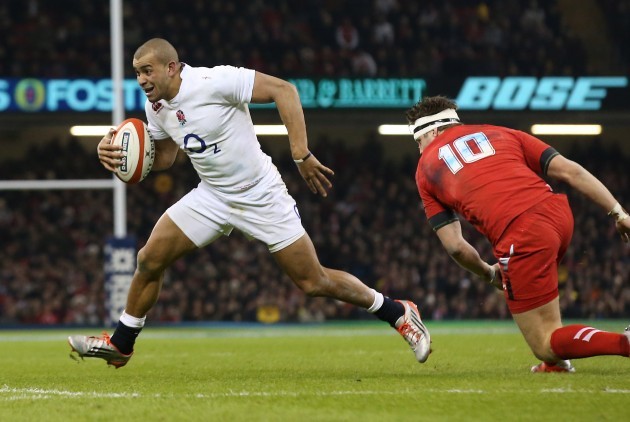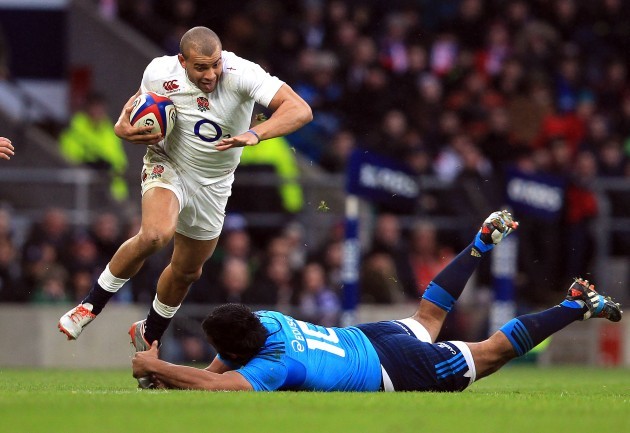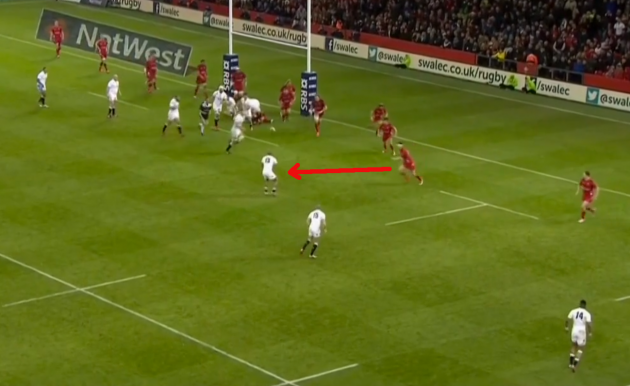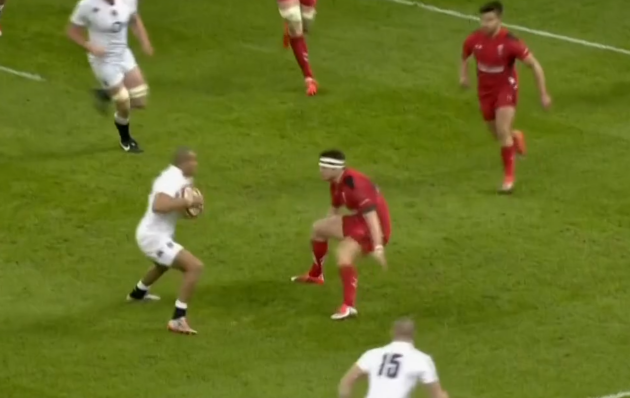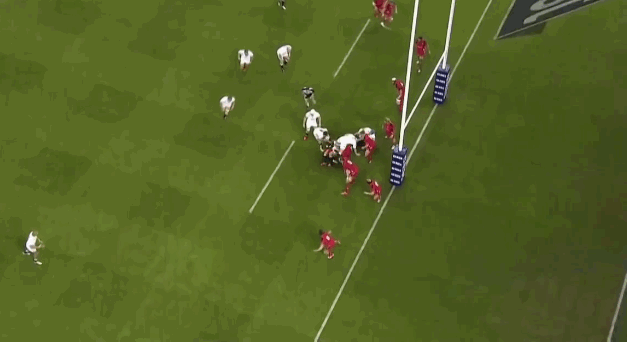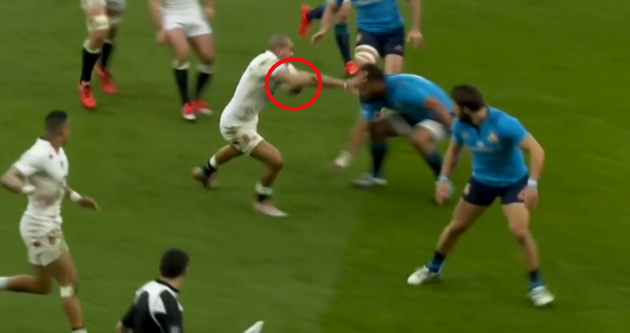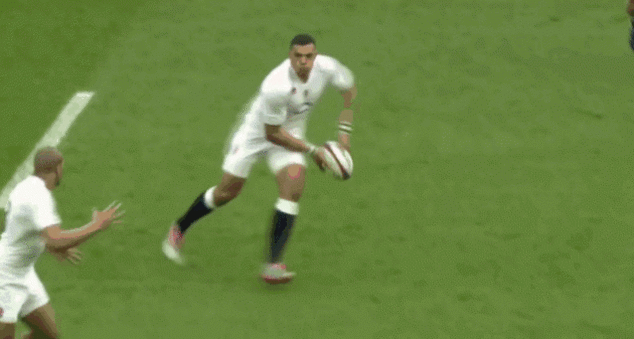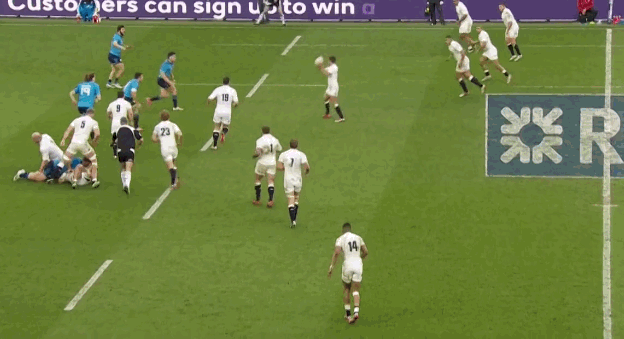ENGLAND UNDER STUART Lancaster haven’t always found tries the easiest to come by, but their attacking prowess has grown in the last two seasons.
They’re the top scorers after two rounds of the Six Nations, although their total of eight was helped by an accommodating Italian defence last time out.
Still, there have been clear improvements and most recently the re-introduction of Jonathan Joseph has made a difference.
Having played six Tests for England across 2012 and 2013, the Bath centre did not feature again until this year. The wait has been worth it for the 23-year-old, however, and he has added the crucial X-factor that England had largely been missing.
“Certainly with ball in hand he’s very exciting, fast feet, very quick,” says Ireland wing Tommy Bowe when asked about Joseph. “He seems to be decent under the high ball, seems to have good handling skills as well.
“He is certainly a player we’ll have to keep an eye on. He’s full of confidence, they like giving him the ball in hand early and he seems to be able to evade tackles and get out of challenges, whatever way he can.”
Phase play
Scoring tries in international rugby is certainly not an easy thing to do, so players who can create them are clearly of great value.
It’s particularly difficult to score after multiple phases of attack, given that defences are now so effective at organising and re-organising after each tackle. Multi-phase passages of attack essentially allow the defence to fall into its structure and make hit after hit.
The majority of tries come in the early phases of attack, whether direct from turnover situations or in the earliest stages of attacks from set-piece, when the defence has not settled into those comfortable patterns and shapes they’ve practiced so often.
That doesn’t mean teams should just give up after three phases and kick the ball away. Multi-phase attack is built around the idea of fatiguing the defence, dragging them around the pitch and tiring them to the point of making an error.
Furthermore, multi-phase attack is about providing backline players with chances to beat defenders one-on-one. Creating huge overlaps is a rarity, so oftentimes manufacturing a one-on-one is a highly desirable outcome.
Having the players who can exploit those one-on-one situations is the real key. One wonders what Like Fitzgerald or Keith Earls might bring to Ireland in this regard, all the more so when we’ve witnessed how Joseph’s flair has added a new dimension to England.
The former London Irish midfielder is a one-on-one specialist, his footwork, pace and fend making him a nightmare to defend against. Three tries in two games, as well as various other threatening moments, mark him out as a real danger to Ireland on Sunday.
Capping it off
We get a strong example of Joseph’s ability to create something on a multi-phase attack in the video above, which shows his try against Wales and some of the preceding English thrusts.
Lancaster’s side drag Wales from the right-side of the 22 to the left, batter into the tacklers to bring about that fatigue [all the while trying to score of course] and then finally, on phase 20, find Joseph and allow him to add the element of flair.
Obviously the outside centre is aided over the line by some poor tackling, but the footwork and dart of pace is electric. There are lessons here for Ireland, as well as the first demonstration of some of Joseph’s traits.
In this situation, Dan Biggar makes the decision to rush up out of the line, looking to hit Joseph ball-and-all. It’s an understandable call close to the tryline and with Mike Brown and Anthony Watson hovering dangerously out wide.
The Wales out-half eats up the first few strides well, but as the ball arrives to Joseph, Biggar eases up and makes the error of briefly sitting on his heels. Against a player like Joseph, that’s an invitation to turn on his exceptional footwork.
That’s exactly what Joseph does, and as we’ll touch upon again later, he loves the opportunity to push off his left foot and beat the defender on the outside, lifting his left arm up for a fend that’s not even required in this instance.
From Ireland’s perspective, the lesson is that they simply have to finish out any attempt to rush up and shut Joseph down early. Haring up without control does of course bring its own risk, but once Biggar has made the decision to shoot here, he has to do everything within his power to drive into Joseph.
Sitting down and allowing the England centre to make a decision simply doesn’t cut it.
We must mention that the speed of Ben Youngs’ pass helps to thwart Biggar, given that the ball arrives earlier than first anticipated, but even still the out-half has to keep moving forward quickly enough to get his shot on Joseph.
It only takes a split second of hesitation for Joseph to beat the defender, so Ireland will be intent on closing out any of their attempts to rush up on England’s 13.
It goes without saying that the secondary missed tackles by George North and Rhys Webb above simply cannot happen. Conor Murray will be particularly alert of Joseph’s threat as he sweeps behind the Irish front-line D.
Long-range danger
Joseph appears to be particularly fond of taking on defenders as the England attack moves from left to right. Most backs have this type of preference, usually based on which foot they’re stronger at stepping off and which hand they fend more powerfully with.
Luke Fitzgerald, for example, loves a hard step back inside off his left foot as play moves from right to left, and there are a number of variations depending on the player.
For Joseph, the chance to fend with his left hand, step outside off his left foot and then use his sharp acceleration is the ideal. Even within England’s two games in this Six Nations, we’ve seen a number of examples.
The try above is obviously one of those, but Joseph’s stunning long-range effort against Italy in round two was another.
This time, it’s not a try or break after multiple phases, rather a score directly from a turnover of possession [that precious source of tries]. There are real similarities to the try against Wales, as well as another demonstration of Joseph’s attacking traits.
It’s a dream attacking situation for a quick back and the Bath centre is understandably desperate to get his hands on the ball. Clubmate George Ford identifies that eagerness and the space in the outside channel, dropping a simple pass on to Joseph nice and early.
Again, the ball is tucked into the right arm, freeing Joseph’s left for a fend to the head of Kelly Haimona. Again, the burst is from left to right. Again, the results are devastating.
We’ve highlighted the right-arm carry above, and it’s something Ireland’s outside defenders might keep in mind when they bite in on Joseph. The primary tackler will have to target the centre’s legs, but the second man in can certainly look to focus on the ball.
Perhaps more instantly relevant in the image above is that Haimona has planted his feet quite some distance away from Joseph, sitting on the heels like Biggar did in our first example.
Joseph’s brief shimmy inside has prompted Haimona to do so, but Irish defenders will have to be more vigilant with their footwork in defence against the England midfielder.
They’ve got to keep their feet alive underneath them, chopping and shifting until that very moment when they can plant close to Joseph’s body and drive into the hit. Sitting like Haimona does here is, again, an invitation to get beaten.
The break ensues and Joseph is provided the opportunity to demonstrate his pace and intelligence to finish.
Although Andrea Masi doesn’t get a dominant shoulder on Joseph in the instance above, he does better to keep his feet moving when the England centre looks to sit him down the the footwork towards Masi’s inside shoulder.
But again, the short clip highlights Joseph’s preference for attempting that outside break moving from left to right, ball tucked in his right arm and the left-sided fend coming out.
Ireland’s incredibly detailed individual player profiles will have them aware of such traits.
Value per involvement
Joseph has by no means been England’s busiest back over the course of their opening two games, with 11 carries and 14 tackles. Each involvement has generally been positive though, and he’s not the type of player Lancaster wants racking up a huge workload.
Joseph operates best when used intermittently, biding his time and awaiting that opportunity to pounce against a fatigued or unsettled and reactionary defence. Charging him into contact repeatedly is wasteful when others can do so more effectively.
The point is that Ireland may not have to tackle Joseph very often, but when they do there will be heavy demands on them to get it absolutely right.
Another element of his game that Ireland will be wary of is short and low kicking, at which Joseph is increasingly impressive.
The effort above trickles into touch, but as anyone who saw Bath’s win in Toulouse earlier this season will testify, Joseph has the deftness to ensure he can regather this type of kick in behind the defence.
As we alluded to earlier, Conor Murray’s role as the sweeper in Ireland’s defence will be key against England, and that certainly applies to Joseph’s short kicks. Rob Kearney at fullback and both of the Ireland wings will need to be equally aware of the possibility.
Briefly before we finish, it’s worth touching upon Joseph’s relationship with George Ford at out-half. The Bath pair have a strong understanding of one another, leading to Joseph running some excellent lines off Ford.
We get one example above [on first phase], although the fact that this was a pre-called move reduces its effectiveness to illustrate the instinctive and intuitive relationship between Joseph and Ford.
Joe Schmidt is a man who consistently reminds us of the value of combinations between players, and England certainly have a strong on with this midfield duo.
No Payne
Joseph will be waiting for opportunities to take on Ireland’s forwards any time England do get through their phases, and the lessons around folding and identifying numbers Schmidt’s men will have learned after conceding to France will apply on Sunday.
Les Kiss will have hammered into the players the need to scan effectively and ensure they are numbered up on both sides of the defensive ruck. A hint of an overlap and Ford will find Joseph to exploit exposed defenders.
From set-piece, Ireland’s strength in midfield defence is reassuring coming into this game. Each of Johnny Sexton, Robbie Henshaw and Jared Payne are effective defenders and are more than capable of winning any contact with Joseph.
What chance of a rare 13 on 13 contest from a lineout or scrum? Joseph would back himself to beat any player one-on-one with a hint of space, but Payne is ready for the test.
“He’s got lightning feet and backs himself,” says Ireland’s outside centre.
“He seems to have all the tricks in the books, so it’s going to be a good challenge if I get picked. You relish playing against those guys, so I just have to close the space down and grass him early.”
